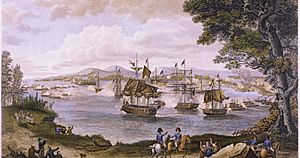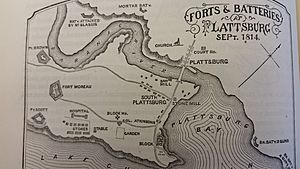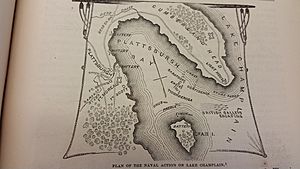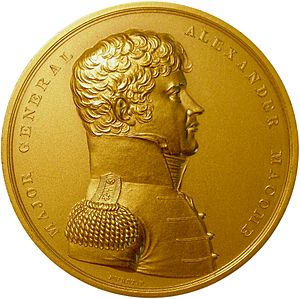Battle of Plattsburgh facts for kids
Quick facts for kids Battle of Plattsburgh |
|||||||
|---|---|---|---|---|---|---|---|
| Part of the War of 1812 | |||||||
 Naval battle on Lake Champlain, an engraving by B. Tanner in 1816, after a painting by Hugh Reinagle |
|||||||
|
|||||||
| Belligerents | |||||||
| Commanders and leaders | |||||||
| Strength | |||||||
|
6,354
2,651 fit to fight
Vermont Militia: 2,200 1 brig 1 schooner 1 sloop 10 gunboats |
11,000 (9,067 engaged) 1 frigate 1 brig 2 sloops 12 gunboats |
||||||
| Casualties and losses | |||||||
| 104 killed 116 wounded Total: 220 |
168 killed 220 wounded 317 captured 234 deserted 1 frigate captured 1 brig captured 2 sloops captured Total: 939 |
||||||
The Battle of Plattsburgh, also known as the Battle of Lake Champlain, was a major fight during the War of 1812. It stopped the last British invasion of the northern United States. This important battle happened in September 1814 near Plattsburgh, New York.
A large British army, led by Lieutenant General Sir George Prévost, and a British naval fleet, led by Captain George Downie, planned to attack Plattsburgh. The town was defended by American soldiers and local militia from New York and Vermont. Brigadier General Alexander Macomb led the American land forces, and Master Commandant Thomas Macdonough commanded the American ships.
On September 11, 1814, Captain Downie's fleet attacked the American ships. After a tough fight, the British fleet was defeated, and Captain Downie was killed. Seeing his navy defeated, General Prévost decided to stop his land attack and retreated back to Canada. He knew his army could not get supplies without control of the lake.
This American victory was very important. At the time, American and British leaders were meeting in Ghent to discuss a peace treaty. The win at Plattsburgh, along with the successful defense at the Battle of Baltimore (which started the next day), meant the British couldn't demand any land from the United States. The Treaty of Ghent, which returned all captured lands to their original owners, was signed three months later.
Contents
Why the Battle Happened
Britain's Big Plans
In 1814, a lot of Britain's army was fighting in Europe. But when Napoleon gave up his power in France, Britain could send 16,000 experienced soldiers to North America. These soldiers had fought in tough battles before.
The British government wanted to attack American territory. They especially wanted to take control of Lake Champlain. This lake was important because it connected to the ocean through Canada, making it a key trade route.
General Prévost decided to attack down the western side of the lake, in New York State. He wanted to avoid fighting in Vermont, which was trading with the British. The main American base on the New York side was at Plattsburgh, New York.
Prévost gathered a huge force of about 11,000 soldiers. These included veteran troops and artillery. However, some soldiers were sick or sent to other places, so about 8,000 actually fought at Plattsburgh.
America Gets Ready
On the American side, Major General George Izard was in charge of the northern army. But in August, he was ordered to take most of his troops, about 4,000, to another important base. This left Brigadier General Alexander Macomb in charge at Plattsburgh with only 1,500 regular soldiers. Many of these were new recruits or sick soldiers.
Macomb quickly called for help. He asked the New York militia to join, and the governor of Vermont sent about 2,000 volunteers. Macomb put everyone to work, digging trenches and building strong defenses.
The main American defense was on a ridge south of the Saranac River. They built three forts and two blockhouses, all connected. This position was strong enough to last for weeks, even if the American ships on the lake were defeated. Macomb even set up a special cannon battery on Crab Island, where his hospital was. Sick or wounded soldiers who could still fire a cannon manned this battery.
Most people in Plattsburgh didn't think the Americans could win. Nearly all 3,000 residents left the city, leaving only the American army behind.
For a while, the British had control of Lake Champlain. They used their ships to raid American towns and stop supplies from reaching Plattsburgh.
However, Lieutenant Thomas Macdonough was building up the American naval forces on the lake. He built several gunboats and, in April 1814, launched two larger ships: the USS Saratoga (a 26-gun corvette) and the USS Ticonderoga (a 14-gun schooner). Just before the battle, they also finished the 20-gun brig USS Eagle. These new ships gave the Americans control of the lake.
To fight back, the British quickly built a large 36-gun frigate called HMS Confiance. Captain George Downie was put in command. Like Macdonough, Downie struggled to get enough men and supplies. He said Confiance wouldn't be ready until September 15. But General Prévost wanted to start his invasion sooner and pushed Downie to get his ship ready faster.
The Invasion Begins
On August 31, General Prévost began marching his army south. Macomb sent out American soldiers and militia to slow them down. The Americans fought delaying actions, setting up roadblocks, burning bridges, and even changing road signs to confuse the British. The British still advanced steadily.
When Prévost reached Plattsburgh on September 6, the Americans pulled back across the Saranac River and tore up the bridge planks. Prévost didn't attack right away. He tried to cross the river, but American soldiers easily pushed them back.
Prévost then started building artillery batteries. The Americans fired back with red-hot cannonballs, setting fire to British-occupied buildings in Plattsburgh. This forced the British to move further away. On September 9, American soldiers launched a night raid, destroying a British rocket battery close to their forts. They killed several British soldiers and got away without any losses.
While small fights continued, the British found a place to cross the Saranac River, about 3 miles upstream from Macomb's defenses. Prévost planned a big attack: when Downie's ships attacked the American fleet, his army would cross the river and attack the American left side.
Getting Ready for Battle
Macdonough knew his fleet had fewer long-range guns than the British. So, he pulled his ships back into Plattsburgh Bay. This forced the British to fight at close range, where the American ships would have a better chance. He prepared his ships by anchoring them in a line and adding special ropes to their anchors. These ropes would let him spin his ships around to use their undamaged side if needed.
The British frigate Confiance was slowly towed up the river. Captain Downie finally joined his fleet on September 9. His ship was still being worked on, and its crew was not fully trained. Downie couldn't attack on September 10 because the wind was not right. But during the night, the wind changed, making an attack possible.
The British fleet sailed early on September 11. Downie scouted the American ships and then ordered his fleet to attack. He told his crew that the British army would attack Plattsburgh as soon as the ships started fighting.
The Fight on the Water
Around 9 AM, the British fleet sailed into the bay. The wind was light, and Downie couldn't get Confiance exactly where he wanted it. As Confiance took damage from American fire, he had to anchor about 300 to 500 yards from Macdonough's flagship, Saratoga. Downie then fired a powerful broadside (all guns on one side) that killed or wounded many of Saratoga's crew. Macdonough was stunned, but quickly recovered. A few minutes later, Downie was killed when a cannon was thrown from its mount by a shot from Saratoga.
Other British ships also struggled. The sloop Chubb was badly damaged and surrendered. The brig Linnet fought well, but another sloop, Finch, ran aground on Crab Island and surrendered. Some British gunboats fought, but others held back.
After about an hour, the American ship Eagle was damaged and had to move. This allowed Linnet to fire on Saratoga. Both flagships, Saratoga and Confiance, had fought each other hard. Confiance's fire became weaker after Downie was killed. On Saratoga, most of the guns on one side were broken.
Macdonough then used his special anchor ropes to spin Saratoga completely around. This allowed him to use the undamaged guns on the other side of his ship. Confiance could not do the same. Its surviving officer tried to turn the ship but only exposed its weak back end to American fire. Helpless, Confiance had to surrender. Macdonough then turned his guns on Linnet, which was also badly damaged and surrendered. The remaining British gunboats left the battle.
After the battle, the surviving British officers offered their swords to Macdonough as a sign of surrender. Macdonough told them, "Gentlemen, return your swords to your scabbards, you are worthy of them." He treated the British wounded and prisoners with great kindness. Many British dead were buried in a mass grave on Crab Island.
The Land Battle
General Prévost's land attack was slow to start. Orders to move weren't given until 10 AM, an hour after the naval battle began. The American and British cannons fired at each other, with the Americans doing slightly better. British attempts to cross the bridges were easily stopped.
When a messenger told Prévost that the British ships had been defeated, he knew he had to retreat. Without the navy to bring supplies and support, taking Plattsburgh would be useless. He ordered his army to retreat.
Some British troops had actually found a way to cross the Saranac River and were ready to attack. But then the orders came to stop the attack. A small group of British soldiers who were ahead of the main army were surrounded by American militia and captured.
The British began their retreat to Canada after dark. They left behind many supplies. During the retreat, at least 234 British soldiers deserted. Most of these were from units that had not fought as much as the veterans.
The British lost 37 killed, 150 wounded, and 57 missing in the land battle. The Americans reported 37 killed, 62 wounded, and 20 missing for their regular troops. However, the total American losses, including militia, were likely higher.
What Happened Next
Macdonough's victory completely stopped the British invasion. It also had an unexpected effect: it made the state of Vermont, which had been trading with the British, fully support the war.
The American victory at Plattsburgh was very important for the peace talks. It showed that the United States could defend its territory. This meant the British could not demand any land from the U.S. in the Treaty of Ghent.
Because of the failure at Plattsburgh and other complaints, Sir George Prévost was removed from his command in Canada. He died before he could defend himself in a military court.
Alexander Macomb was promoted to Major General and later became the top general of the United States Army. Thomas Macdonough was promoted to Captain and is remembered as the "Hero of Lake Champlain." To honor their bravery, the U.S. Congress gave special gold medals to Macdonough, Macomb, and two other naval officers.
Images for kids







